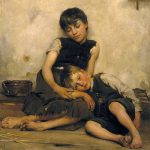
Thomas Gainsborough, one of the leading portrait and landscape painters of 18th-century England, was born on May 14, 1727, in Sudbury, Suffolk. Renowned for his exceptional ability to capture the natural beauty of his subjects and landscapes, Gainsborough played a pivotal role in the development of British art during the Georgian era.

Gainsborough’s early artistic talents were evident, and he received his initial training in London under the tutelage of Hubert Gravelot, a French artist, and later at the St. Martin’s Lane Academy. The young artist’s keen interest in landscapes and the English countryside began to emerge during these formative years, foreshadowing a lifelong passion.
Margaret Burr
In 1746, Gainsborough married Margaret Burr, and the couple settled in Ipswich, where the artist established his first studio. During this period, he primarily painted landscapes, showcasing a distinctive style that emphasized the pastoral beauty of nature. His early works, such as “The Harvest Wagon” and “Cornard Wood,” revealed an affinity for capturing the atmospheric effects of light and the subtle nuances of the English countryside.

Gainsborough’s move to Bath in 1759 marked a significant phase in his career. Bath, a fashionable and thriving spa town, provided the artist with access to a wealthier clientele interested in portrait commissions. Gainsborough’s portraits during this period, including those of notable figures like Jonathan Buttall and Mary Countess Howe, displayed a refined technique and an ability to convey the individuality and character of his sitters.
The artist’s reputation continued to grow, leading to his election as a founding member of the Royal Academy of Arts in 1768. Despite his initial involvement, Gainsborough’s relationship with the Academy became strained due to artistic differences and a desire for more independence in his work. He withdrew from regular participation but continued to exhibit his works in London.

Gainsborough’s portraits are characterized by a remarkable ability to capture the personality of his subjects and a mastery of brushwork. His sitters, whether members of the aristocracy or common citizens, were rendered with a sense of naturalism and grace. The famous portrait known as “The Blue Boy,” depicting a young man in a blue satin costume, is an iconic example of Gainsborough’s skill in creating a vibrant and memorable image.
Love of Landscapes
In addition to portraiture, Gainsborough’s love for landscapes remained a constant theme throughout his career. His landscapes, often featuring rural scenes and woodland settings, conveyed a deep appreciation for the beauty of the English countryside. Notable examples include “Mr. and Mrs. Andrews” and “The Cottage Door.”
Gainsborough’s later years saw a return to London, where he continued to receive commissions and garnered acclaim for his portraits. His portraits of King George III and Queen Charlotte, commissioned by the royal family, added to his prestige. Despite his success, Gainsborough maintained a sense of artistic integrity, often expressing a preference for his landscape work.

Thomas Gainsborough passed away on August 2, 1788, at the age of 61. His artistic legacy endures through the significant impact he had on the British art scene during the 18th century. Gainsborough’s innovative approach to portraiture, his evocative landscapes, and his dedication to capturing the essence of his subjects have solidified his place among the master artists of his era. Today, his works are celebrated in major art institutions, showcasing the enduring influence of this eminent English painter.






